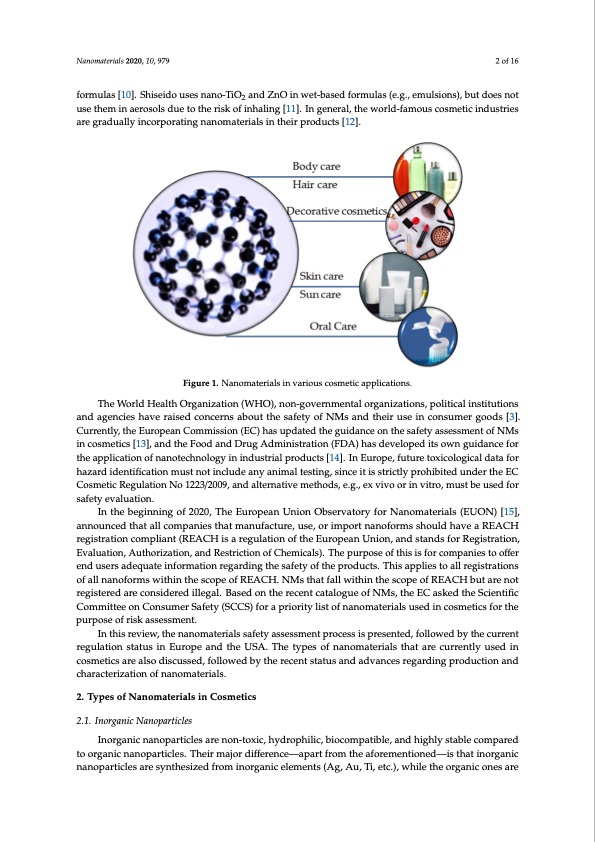
PDF Publication Title:
Text from PDF Page: 002
Evaluation, Authorization, and Restriction of Chemicals). The purpose of this is for companies to offer end users adequate information regarding the safety of the products. This applies to all registrations of all nanoforms within the scope of REACH. NMs that fall within the scope of REACH but are not registered are considered illegal. Based on the recent catalogue of NMs, the EC asked the Scientific Committee on Consumer Safety (SCCS) for a priority list of nanomaterials used in Nanomaterials 2020, 10, 979 2 of 16 cosmetics for the purpose of risk assessment. In this review, the nanomaterials safety assessment process is presented, followed by the formulas[10].Shiseidousesnano-TiO andZnOinwet-basedformulas(e.g.,emulsions),butdoesnot 2 current regulation status in Europe and the USA. The types of nanomaterials that are currently used use them in aerosols due to the risk of inhaling [11]. In general, the world-famous cosmetic industries in cosmetics are also discussed, followed by the recent status and advances regarding production are gradually incorporating nanomaterials in their products [12]. and characterization of nanomaterials. Figure 1. Nanomaterials in various cosmetic applications. Figure 1. Nanomaterials in various cosmetic applications. The World Health Organization (WHO), non-governmental organizations, political institutions 2. Types of Nanomaterials in Cosmetics and agencies have raised concerns about the safety of NMs and their use in consumer goods [3]. Currently, the European Commission (EC) has updated the guidance on the safety assessment of NMs 2.1. Inorganic Nanoparticles in cosmetics [13], and the Food and Drug Administration (FDA) has developed its own guidance for the application of nanotechnology in industrial products [14]. In Europe, future toxicological data for Inorganic nanoparticles are non-toxic, hydrophilic, biocompatible, and highly stable compared hazard identification must not include any animal testing, since it is strictly prohibited under the EC to organic nanoparticles. Their major difference—apart from the aforementioned—is that inorganic Cosmetic Regulation No 1223/2009, and alternative methods, e.g., ex vivo or in vitro, must be used for nanoparticles are synthesized from inorganic elements (Ag, Au, Ti, etc.), while the organic ones are In the beginning of 2020, The European Union Observatory for Nanomaterials (EUON) [15], announced that all companies that manufacture, use, or import nanoforms should have a REACH registration compliant (REACH is a regulation of the European Union, and stands for Registration, Evaluation, Authorization, and Restriction of Chemicals). The purpose of this is for companies to offer end users adequate information regarding the safety of the products. This applies to all registrations of all nanoforms within the scope of REACH. NMs that fall within the scope of REACH but are not registered are considered illegal. Based on the recent catalogue of NMs, the EC asked the Scientific Committee on Consumer Safety (SCCS) for a priority list of nanomaterials used in cosmetics for the purpose of risk assessment. In this review, the nanomaterials safety assessment process is presented, followed by the current regulation status in Europe and the USA. The types of nanomaterials that are currently used in cosmetics are also discussed, followed by the recent status and advances regarding production and characterization of nanomaterials. 2. Types of Nanomaterials in Cosmetics 2.1. Inorganic Nanoparticles Inorganic nanoparticles are non-toxic, hydrophilic, biocompatible, and highly stable compared to organic nanoparticles. Their major difference—apart from the aforementioned—is that inorganic nanoparticles are synthesized from inorganic elements (Ag, Au, Ti, etc.), while the organic ones are safety evaluation. synthesized from polymers. One of the most widely used inorganic nanoparticles for sunscreens isPDF Image | Nanomaterials in Cosmetics: Recent Updates

PDF Search Title:
Nanomaterials in Cosmetics: Recent UpdatesOriginal File Name Searched:
nanomaterials-10-00979-v2.pdfDIY PDF Search: Google It | Yahoo | Bing
Turbine and System Plans CAD CAM: Special for this month, any plans are $10,000 for complete Cad/Cam blueprints. License is for one build. Try before you buy a production license. More Info
Waste Heat Power Technology: Organic Rankine Cycle uses waste heat to make electricity, shaft horsepower and cooling. More Info
All Turbine and System Products: Infinity Turbine ORD systems, turbine generator sets, build plans and more to use your waste heat from 30C to 100C. More Info
CO2 Phase Change Demonstrator: CO2 goes supercritical at 30 C. This is a experimental platform which you can use to demonstrate phase change with low heat. Includes integration area for small CO2 turbine, static generator, and more. This can also be used for a GTL Gas to Liquids experimental platform. More Info
Introducing the Infinity Turbine Products Infinity Turbine develops and builds systems for making power from waste heat. It also is working on innovative strategies for storing, making, and deploying energy. More Info
Need Strategy? Use our Consulting and analyst services Infinity Turbine LLC is pleased to announce its consulting and analyst services. We have worked in the renewable energy industry as a researcher, developing sales and markets, along with may inventions and innovations. More Info
Made in USA with Global Energy Millennial Web Engine These pages were made with the Global Energy Web PDF Engine using Filemaker (Claris) software.
Infinity Turbine Developing Spinning Disc Reactor SDR or Spinning Disc Reactors reduce processing time for liquid production of Silver Nanoparticles.
| CONTACT TEL: 608-238-6001 Email: greg@infinityturbine.com | RSS | AMP |